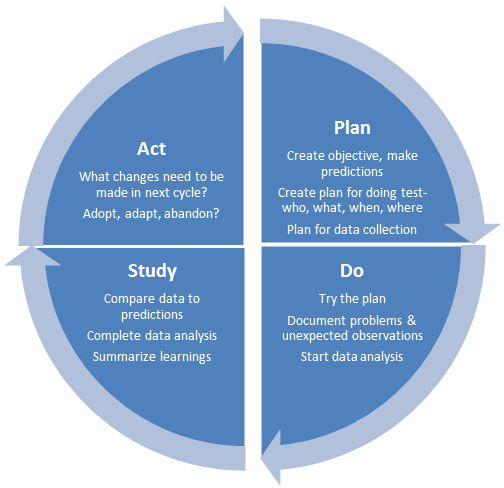
Tackling Change
A Toolkit for Quality Process Improvement
Step 5:
Design and test changes
Key Point
Test small, test often, test on a segment.
-
Identify initial test of change. Suggestions for test of change goals:
Improve the Patient Experience — Talk to patients and families to understand their perception of care and understand how you can engage them in their care.
Eliminate Waste — Look for ways of eliminating any activity or resource that does not add value to your customer.
Reduce Variation — Reduce variation to improve the predictability of outcomes and reduce the frequency of poor results.
Error Proof — Reduce errors by redesigning the system using human factors design principles to make it less likely for people in the system to make errors.
Improve Work Flow — Improve the flow of work in processes to improve the quality of the goods and services produced by those processes.
Optimize Inventory — Inventory of all types is a possible source of waste in organizations; understanding where inventory is stored in a system is the first step in finding opportunities for improvement.
Manage Time — Reduce waiting times for services, lead times for orders and deliveries, and cycle times for all functions in the organization.
-
Make sure there are no regulatory or safety issues with test of change.
-
Plan your test of change:
Define scope of test of change.
Define time frame of test of change.
-
Identify who to test with — one doctor, one nurse, one patient, one tech, one day, one shift.
Pick the population and the staff who you think you will have the most success with. Set yourself up for success!
-
Use a tool to keep track of your tests of change. Samples of PDSA tracking tools follow.
-
Conduct initial test of change — begin rapid cycle tests of change using PDSA model.

-
Test small, fail early. You can always go back to the way it was yesterday! If your test worked, try it with a different population or staff — try it on day shift, on night shift, on weekends, with an enthusiastic team member, with someone who is more resistant to change. If your test ran into problems, tweak and try it again. If it was a total failure, abandon it!
-
Update core team, people whose permission you need, people whose expertise you need, and people to be kept in the loop as needed. Consider how to communicate change to key stakeholders. Use a project management tool to keep the group organized and on target.
-
Do you need help with this step? Drop us an email at QualityQuestions@upmc.edu and Wolff Center staff will be happy to help you.
